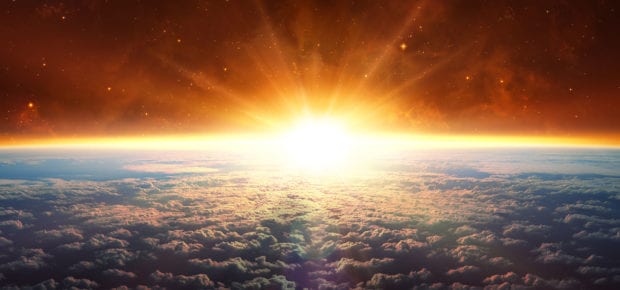June 9, 2017
By: André Gradvohl, IEEE Senior Member and Assistant Professor at University of Campinas
We all know that the Sun is one of the main sources of heat for the Earth. What most of us do not know is that many phenomena occurring in the Sun have an impact on strategic services on Earth. It affects telecommunications, power transmission and even some flight routes that cross the poles. We call this Space Weather, the repercussion of solar phenomena on our planet. The effects of Space Weather are mitigated so they do not affect our day to day life.
The Sun produces its energy through the nuclear fusion of hydrogen nuclei into helium. This activity generates light, radiation, and plasma, as well as a very strong magnetic field. The solar magnetic field keeps changing all the time and these changes cause the Space Weather. Among the main phenomena that occur in the Sun and reach the Earth are sunspots, solar explosions, and coronal mass ejections or CMEs.
One of the results of solar activity is sunspots. These spots appear in the solar photosphere – the visible part of the Sun – as dark spots, since they are areas with a lower temperature than the rest of the photosphere. In addition to being darker, they have associated magnetic fields.
When two sunspots with opposing magnetic fields approach, they create magnetic arcs. These arcs can rupture and, when this happens, a solar explosion occurs. One of the effects of this explosion is the emission of X-rays.
There are five classes of X-ray explosions:
- Classes A and B are very weak.
- Class C is intermediate and has little repercussions on Earth.
- Class M explosions already have some consequences, such as brief blackouts of radio transmissions at the poles of the Earth.
- Class X explosions can cause radiation storms and radio blackouts on a global scale.
In some of these explosions, in addition to X-ray emissions, there may be coronal mass ejections (CME). The coronal mass is formed mainly by protons and electrons, which are ejected at very high speed. They travel around 500 to 1000 kilometers per second.
When it arrives on Earth, the CME causes the Aurora Borealis (in the North Pole) and the aurora Australis (in the South Pole). However, depending on its volume, the CME compresses the terrestrial magnetosphere and ionosphere, two invisible layers – one magnetic and other electron formed – that protect the Earth. When these layers are compressed, problems occur in GPSs and in high-frequency radio transmissions. They can also cause problems for satellites, astronauts, or other equipment in orbit.
Therefore, just like the Earth’s weather, we also need techniques to predict the effects of the Space Weather. There are centers in Brazil and around the world dedicated to making these predictions. The next step in the research is to forecast these predictions automatically. For this, we are already studying methods of data mining and Big Data to predict these phenomena as far in advance as possible.





 The Impact of Technology in 2025
The Impact of Technology in 2025 Quantum and AI: Safeguards or Threats to Cybersecurity?
Quantum and AI: Safeguards or Threats to Cybersecurity? Why AI Can't Live Without Us
Why AI Can't Live Without Us Bits, Bytes, Buildings and Bridges: Digital-Driven Infrastructure
Bits, Bytes, Buildings and Bridges: Digital-Driven Infrastructure Impact of Technology in 2024
Impact of Technology in 2024 Emerging AI Cybersecurity Challenges and Solutions
Emerging AI Cybersecurity Challenges and Solutions The Skies are Unlimited
The Skies are Unlimited Smart Cities 2030: How Tech is Reshaping Urbanscapes
Smart Cities 2030: How Tech is Reshaping Urbanscapes Impact of Technology 2023
Impact of Technology 2023 Cybersecurity for Life-Changing Innovations
Cybersecurity for Life-Changing Innovations Smarter Wearables Healthier Life
Smarter Wearables Healthier Life Infrastructure In Motion
Infrastructure In Motion The Impact of Tech in 2022 and Beyond
The Impact of Tech in 2022 and Beyond Cybersecurity, Technology and Protecting Our World
Cybersecurity, Technology and Protecting Our World How Technology Helps us Understand Our Health and Wellness
How Technology Helps us Understand Our Health and Wellness The Resilience of Humanity
The Resilience of Humanity Harnessing and Sustaining our Natural Resources
Harnessing and Sustaining our Natural Resources Creating Healthy Spaces Through Technology
Creating Healthy Spaces Through Technology Exceptional Infrastructure Challenges, Technology and Humanity
Exceptional Infrastructure Challenges, Technology and Humanity The Global Impact of IEEE's 802 Standards
The Global Impact of IEEE's 802 Standards Scenes of our Cyber Lives: The Security Threats and Technology Solutions Protecting Us
Scenes of our Cyber Lives: The Security Threats and Technology Solutions Protecting Us How Millennial Parents are Embracing Health and Wellness Technologies for Their Generation Alpha Kids
How Millennial Parents are Embracing Health and Wellness Technologies for Their Generation Alpha Kids Space Exploration, Technology and Our Lives
Space Exploration, Technology and Our Lives Global Innovation and the Environment
Global Innovation and the Environment How Technology, Privacy and Security are Changing Each Other (And Us)
How Technology, Privacy and Security are Changing Each Other (And Us) Find us in booth 31506, LVCC South Hall 3 and experience the Technology Moon Walk
Find us in booth 31506, LVCC South Hall 3 and experience the Technology Moon Walk Virtual and Mixed Reality
Virtual and Mixed Reality How Robots are Improving our Health
How Robots are Improving our Health IEEE Experts and the Robots They are Teaching
IEEE Experts and the Robots They are Teaching See how millennial parents around the world see AI impacting the lives of their tech-infused offspring
See how millennial parents around the world see AI impacting the lives of their tech-infused offspring Take the journey from farm to table and learn how IoT will help us reach the rising demand for food production
Take the journey from farm to table and learn how IoT will help us reach the rising demand for food production Watch technical experts discuss the latest cyber threats
Watch technical experts discuss the latest cyber threats Explore how researchers, teachers, explorers, healthcare and medical professionals use immersive technologies
Explore how researchers, teachers, explorers, healthcare and medical professionals use immersive technologies Follow the timeline to see how Generation AI will be impacted by technology
Follow the timeline to see how Generation AI will be impacted by technology Learn how your IoT data can be used by experiencing a day in a connected life
Learn how your IoT data can be used by experiencing a day in a connected life Listen to technical experts discuss the biggest security threats today
Listen to technical experts discuss the biggest security threats today See how tech has influenced and evolved with the Games
See how tech has influenced and evolved with the Games Enter our virtual home to explore the IoT (Internet of Things) technologies
Enter our virtual home to explore the IoT (Internet of Things) technologies Explore an interactive map showcasing exciting innovations in robotics
Explore an interactive map showcasing exciting innovations in robotics Interactively explore A.I. in recent Hollywood movies
Interactively explore A.I. in recent Hollywood movies Get immersed in technologies that will improve patients' lives
Get immersed in technologies that will improve patients' lives